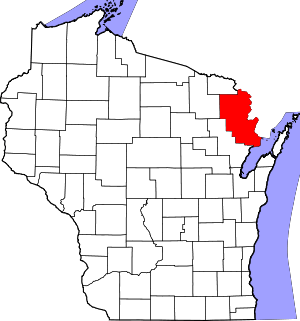Cedarville, Wisconsin
Cedarville is an unincorporated community located in the towns of Amberg and Wausaukee, Marinette County, Wisconsin, United States.
Cedarville, Wisconsin | |
|---|---|
 Cedarville, Wisconsin  Cedarville, Wisconsin | |
| Coordinates: 45°27′13″N 87°58′58″W | |
| Country | |
| State | |
| County | Marinette |
| Elevation | 255 m (837 ft) |
| Time zone | UTC-6 (Central (CST)) |
| • Summer (DST) | UTC-5 (CDT) |
| Area code(s) | 715 & 534 |
| GNIS feature ID | 1562873[1] |
Geography

Cedarville is 6 miles (9.7 km) north-northwest of the village of Wausaukee, at the intersection of Amberg–Wausaukee Road and Old 38 Road[2] at an elevation of 837 feet (255 m).[1] It is located along the Escanaba and Lake Superior Railroad. Cedarville is connected by road to Athelstane (via County Highways V and C) to the west, Amberg to the north, and Wausaukee to the south. Little Wausaukee Creek and Cedar Lake lie the southwest, and Cedarville Creek flows to the east.[2]
Name
The name Cedarville refers to the white cedar that grew and was cut in the area. The railroad station at Cedarville was used for storage and transport of cedar in the early 20th century.[3][4]
History
The railroad connection to Cedarville was built by the Bird and Wells Lumber Company in the 1890s.[5] In 1906, forest fires caused significant damage in Cedarville. Railroad cars loaded with wood burned on the tracks, and cedar-filled drying kilns burned. Together with neighboring Wausaukee, losses were estimated at $200,000.[3] By 1916, Cedarville had 54 households; the settlers were mostly farmers from Indiana, Illinois, and Iowa.[6] That same year, the community was platted as a town with two named streets, and it had a train station, potato warehouse, school, church, store, garage, and post office.[7] An agricultural fair was held in Cedarville in the 1920s,[8] and the settlement received electricity in 1925.[9] However, by 1925 the settlement had also started to decline, with many families moving away.[10]
References
- U.S. Geological Survey Geographic Names Information System: Cedarville, Wisconsin
- Wausaukeee Quadrangle Wisconsin–Marinette Co., 15 Minute Series (Topographic). 1963. Map, 1:62,500. Washington, DC: U. S. Geological Survey.
- "The Forests Are Swept by Flames". The Green Bay Press-Gazette. May 19, 1906. p. 1. Retrieved December 25, 2019 – via Newspapers.com.

- "Timber for Cheese Boxes Being Cut". The Green Bay Press-Gazette. December 12, 1912. p. 12. Retrieved December 25, 2019 – via Newspapers.com.

- "The Bird and Wells Lumber Company". The Green Bay Press-Gazette. May 29, 1894. p. 3. Retrieved December 25, 2019 – via Newspapers.com.

- "Cedarville Forms Anti-Tobacco Club". The Green Bay Press-Gazette. August 26, 1916. p. 8. Retrieved December 26, 2019 – via Newspapers.com.

- "Cedarville Switch 1917 Now Prosperous Town". The Green Bay Press-Gazette. September 28, 1916. p. 4. Retrieved December 26, 2019 – via Newspapers.com.

- "Four Community Fairs Scheduled". The Green Bay Press-Gazette. October 17, 1924. p. 16. Retrieved December 29, 2019 – via Newspapers.com.

- "W. P. S. Buys Light Plant at Pembine". The Green Bay Press-Gazette. March 21, 1925. p. 11. Retrieved December 29, 2019 – via Newspapers.com.

- "Consider Closing of School at Cedarville". The Green Bay Press-Gazette. November 20, 1925. p. 11. Retrieved December 31, 2019 – via Newspapers.com.

